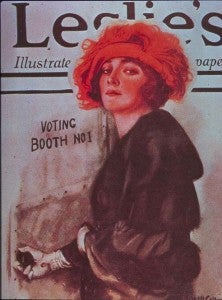Title: “The Mystery of 1920,” Leslie’s Illustrated Weekly Newspaper, cover, September 11, 1920.
About the image: A well-dressed young woman enters “Voting Booth No. 1.”
Why does Natomas Charter School Teacher Jeff Pollard find this image interesting?
“I use this image as part of my introduction to a primary source investigation about the New Woman of the 1920s using Marchand Archive resources. I think it is a fantastic image because it gets students’ attention, and the increased status for women in the 1920s is so clear. The image itself does a lot of work for me as a teacher by setting up my investigation. The title of the image is “The Mystery of 1920.” So I ask students, “What is the mystery?” Students clearly can see that this New Woman was confident, stylish, and even a bit egotistical in her glance. Through analyzing the image students come to the conclusion that the mystery of 1920 is the question: How will America be changed as women step into voting and toward political equality? It is a great example of how images can be used to set up investigations, get students’ attention, and link a concept to an image. I come back to this image later in the year when I review for the the standardized test required by California. I show this image again and ask students the following questions: What was the mystery? Why 1920? What amendment granted women suffrage? The students remember the image and remember the content associated with it as well.”
Related Topics/Themed Collections: Twenties, 20’s pop culture, women
Lessons in the Marchand Collection:
- The “New Woman” of the 1920s by Jeff Pollard, CHSS 11.5.4, 11.5.7, IN PRINT – AVAILABLE ONLY IN THE MARCHAND ROOM
- Slang in the 1920s by Kevin Williams, CHSS 11.5, IN PRINT – AVAILABLE ONLY IN THE MARCHAND ROOM
Resources Available in the Marchand Collection:
- Roland Marchand, Advertising the American Dream: Making Way for Modernity, 1920-1940, Berkeley: University of California Press, 1985.
Share your ideas! How would you use this image? Let us know here.
